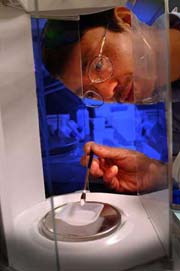Cells’ Ability to Live Without Oxygen Give Clues for Treating Major Diseases

Some cells in the kidney can not only survive without sufficient oxygen, but actually begin stretching and multiplying to make up for their fallen brethren, says a Medical College of Georgia researcher.
Some cancer cells similarly adapt; as a tumor grows too big for its blood and oxygen supply, some cells transform so they can survive without oxygen, emerging stronger and treatment resistant, says Dr. Zheng Dong, cell biologist.
He doubts that these two very different cell types travel the identical road to survival. “But the final result is the same,” he says. “They simply become stronger, tougher and more resistant to injury, and for those in tumors, more resistant to cancer therapies.”
The researcher, whose latest findings are featured in recent issues of the Journal of Biological Chemistry and American Journal of Pathology, is tracing the steps each takes, ultimately to see whether cells that would be lost to stroke and heart attack can be made equally durable — and, possibly, whether cancer cells can be made vulnerable.
“We want to define the signaling pathways for cell injury and death. We want to know how these cells are killed,” he says. “Our other focus is cellular adaptation to stress, basically why other cells can survive. We want to define the molecular alterations at the level of gene expression,” which he believes are key to survival and proliferation.
He has found at least two key pieces to survival in the tubular cells of the kidney. Tubular cells are the most common cells in the kidney, comprising the extensive channels through which body’s entire fluid volume flows many times each day so that needed substances can be absorbed and excess fluid and waste excreted in the urine. The cells are durable, busy and, likely because of their high activity, have a high oxygen demand.
Yet when the oxygen supply is lost or diminished, as it can be in cardiovascular disease and diabetes, Dr. Dong has found that some tubular cells seem to adapt by up-regulating two genes, IAP-2 and Bcl-xL. When he knocks down the genes, the cell’s sensitivity to injury returns.
“This response, I believe, provides a mechanism for those cells to survive ischemic stress and gives them a chance to repair the injured kidney,” says Dr. Dong, whose discovery of the role of these death-inhibitory genes has won him numerous awards in the past three years including the Lyndon Baines Johnson Research Award from the American Heart Association, Texas Affiliate; the Patricia W. Robinson Young Investigator Award from the National Kidney Foundation; and the Carl W. Gottschalk Scholar Award from the American Society of Nephrology.
His latest finding helps explain why other cells are lost, detailing how in an oxygen-deprived state, a little-understood protein called Bax found in the fluid portion of a cell moves into the cell’s powerhouse, or mitochondria, where it forms holes in the walls. Contained, the contents of the mitochondria give the cell energy; uncontained, they cause cell death, or apoptosis.
“We are focusing on the kidney, but our studies are applicable to heart attack and stroke and possibly cancer as well,” says Dr. Dong, who believes his work will ultimately lead to gene therapy where the survival genes could be up-regulated in troubled cells and down-regulated in cells, such as cancer cells, that need to die.
“Why are some cells so durable and others so vulnerable?” he says. “Hopefully we can identify some therapeutic tool that is either genetic or pharmaceutical to switch these as needed. We want to keep kidney cells strong enough to be resistant to ischemia and hopefully we can identify a few more things in cancer cells that make them more vulnerable.”
Dr. Dong’s work is supported by the National Institutes of Health, the American Society of Nephrology and the National Kidney Foundation.
Media Contact
More Information:
http://www.mcg.edu/news/2003NewsRel/dong.htmlAll latest news from the category: Health and Medicine
This subject area encompasses research and studies in the field of human medicine.
Among the wide-ranging list of topics covered here are anesthesiology, anatomy, surgery, human genetics, hygiene and environmental medicine, internal medicine, neurology, pharmacology, physiology, urology and dental medicine.
Newest articles

Breakthrough in magnetism that could transform quantum computing and superconductors
Researchers discover new magnetic and electronic properties in kagome magnet thin films. A discovery by Rice University physicists and collaborators is unlocking a new understanding of magnetism and electronic interactions…

NASA to launch innovative solar coronagraph to Space Station
NASA’s Coronal Diagnostic Experiment (CODEX) is ready to launch to the International Space Station to reveal new details about the solar wind including its origin and its evolution. Launching in…

Boosting efficiency in mining with AI and automation
“Doing instead of procrastinating”. This is the AI strategy presented by Prof. Constantin Haefner, Director of the Fraunhofer Institute for Laser Technology ILT, at the “AKL’24 – International Laser Technology…



